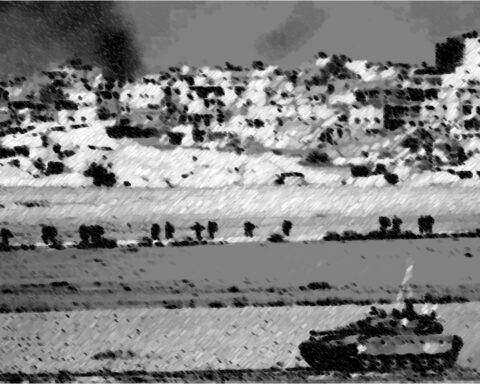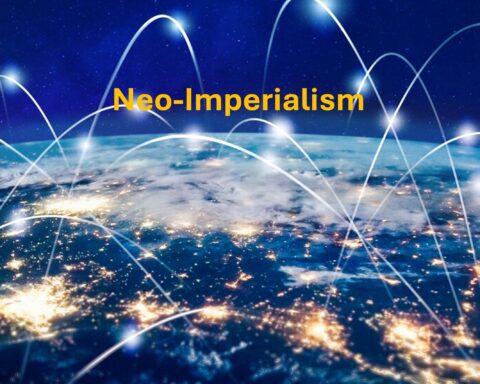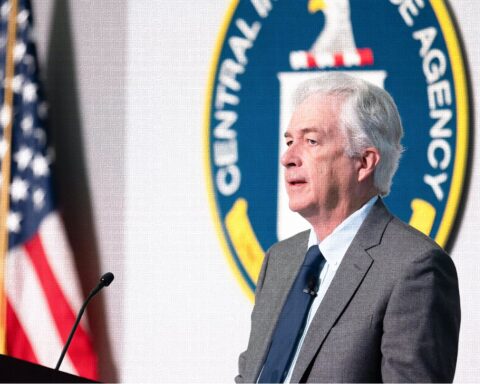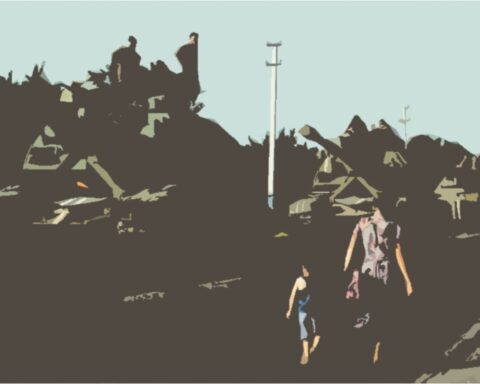I evaluate an important war that has reached its second year, predicted to quickly pass its third year, and concerns almost everyone. Looking from today to tomorrow, while developments seem to be against Ukraine, can any changes be made to the situation? Or will today’s ambiguity continue? How are the problems on the front lines and in the strategic field developing? Can Putin make his chess moves skillfully?
On February 24, 2022, Russia began implementing a comprehensive invasion plan against Ukraine. The war continues. We have witnessed events on the front lines and in the world, and we have been filled to the brim with different thoughts. Where are we today?
Initially, with approximately 110,000 troops and armored units, the Russians amassed a large deployment to the north and east of Ukraine. The capital, Kiev, was the initial target. According to the plan, Kiev would be captured quickly, and Ukraine would be governed by a pro-Russian leader. In the northeast, the important industrial city of Kharkiv was another target. The Ukrainian army and people fiercely resisted this invasion. At this point, Russia was the main culprit militarily. Because it was clear from the beginning that such an offensive plan would not yield results. At least I saw and stated this situation that way in those days. I said that it did not comply with the Principles of War that the Russians followed.
Later, there was an adjustment from the Russians. Russia completely withdrew its failed units from the north and predominantly redeployed them to the east to regroup. Thus, Russian units in the east were reinforced. Now the name of the plan was clear: Special Military Operation. Its goal was to seize a certain area and coastal region in Crimea and the Donbass region. Wanting to maintain their presence in the Black Sea, the Russians would move from east to west as much as they could over time. In plain terms, the Russians wanted to stay on the Dnieper line.
In the winter of 2023, the Russians dug trenches along the Dnieper River to form three lines and began implementing the general defense plan on the front. This was also referred to as the “Surovikin line” after the commander. Zelensky launched or prepared to launch a counteroffensive in the spring.
This Russian defensive style applied in the First World War was actually a method they were familiar with. After suffering excessive losses of weapons, ammunition, and soldiers in unexpected amounts from the beginning of the war, the Russians began to breathe a little when they switched to this defensive posture and gained time to regroup. Because it was seen in this war that the Russians had deficiencies in command and control, logistics, but most importantly in military training. They couldn’t withstand heavy weapons in harsh conditions and suffered heavy losses against modern weapon systems. The situation was no different in the Black Sea; they relied on mines and submarine attacks.
Ukraine was receiving advanced weapon assistance from the West, especially the United States. After their training, soldiers who would use them gradually came to reinforce the army. Operational intelligence was Western-supported. But there was also a limit to this. There was also a limit to being able to be sufficient against the rich Russian army resources through transportation from outside. Ukraine was receiving continuous and packaged Western support. Nearly $60 billion worth of weapons and ammunition aid was delivered to Ukraine. Among these were systems such as HIMARS, M777, and PATRIOT. The military aid Ukraine received, like other aids, began to melt on the front line according to the selected operational plans. If these plans were to continue, this aid also had to continue uninterrupted and even increase. As the war prolonged, the main issue became aid. This was true for both sides, both Russia and Ukraine. But Ukraine needed aid the most.
The Ukrainian counteroffensive launched in the spring of 2023 did not achieve results. It was clear it wouldn’t. Firstly, the Russians had prepared their trenches accordingly, meaning they were ready. Secondly, Ukraine had no air superiority. Thirdly, the front was very wide, and Ukraine did not have enough military power to maneuver on such a scale on the front. If they attempted a larger offensive using more force, it could be a big trap for them. This was similar to the initial mistake made by the Russians.
Ukraine’s allies began to consider. Firstly, military aid to Ukraine should continue simultaneously, and the assistance Russia receives from the world should be cut off. Secondly, could this war be ended at some point? Where could a decision point be? The front is one thing, and the strategic expectations and claims are very different!
Meanwhile, Ukraine needed to do something, and for this purpose, it turned to asymmetric attacks. Asymmetric attacks were carried out in various forms, such as drone attacks from sea and air, which could have an effect from Moscow to the Black Sea. In response, the Russians also continued punitive destruction. In the attacks on Ukrainian cities and military facilities, hypersonic cruise missiles were used from the air and sea. In addition, Moscow began to receive drones in large quantities from Iran and continues to use them.
All this while, in the winter of 2024, it was witnessed that Zelensky felt the need to change the Defense Minister and the Chief of General Staff. Presidential elections are being held in the United States. The verbal duel between Biden and Trump continues. The need for weapons and ammunition for Ukraine may not be as important as it is now, but the United States has begun to move slowly on this issue. The House of Representatives is considering it! If the United States cannot provide Ukraine with weapons and ammunition today, it must have felt the need to announce another new sanctions package against Russia. NATO, which continues to expand, is conducting one of the largest deterrence and determination exercises in Europe. Europe, especially, can be said to be on edge. European people are anxious, especially about the nuclear threat. Poland had seen so many soldiers during World War II. Tensions are escalating in the Baltic region. Despite many military failures and setbacks, Putin maintains his leadership position and the power in the Kremlin is still strong. Putin seems to have overcome the problem created by the Wagner mercenary company and its owner Prigozhin, according to Russian secret service methods. Also, Putin is held responsible for the death of activist Navalny in a prison in the Arctic region. With all this, we enter the third year of the war.
Russia evaluated its military situation and made it more suitable for itself. This is a situation that gives it more advantage. So, if the Western world cannot provide Ukraine with sufficient weapons and ammunition, will the Russians, one step each year, make progress step by step beyond the Dnieper River, for example, in the next ten years? How can the economy of Ukraine, which depends on Western companies, where the fields are planted but the product cannot be harvested, or even if harvested, at what cost it is sold, be sufficient against all these war difficulties?
Western writers and politicians who know well what war is are pressuring the United States these days; they say, “Do not leave Ukraine alone, do not play into the hands of the Russian army.” Once the initiative, a principle of war, passes to the Russian army, there is concern that its bill could go as far as European cities. Then people in countries like Estonia, Moldova, and Poland would be justified in feeling anxious. Considering from the Western perspective, in this case, the initiative should never be given to the Russians. Therefore, continuous shipments of not only F-16 fighter jets but also numerous weapons and ammunition are necessary.
On the other hand, the world is facing other problems. For example, while Covid-19 and the resulting economic and trade issues continue, governments’ attention has been diverted to many areas in terms of global solutions and new problem areas. As events in regions such as the Middle East, Pacific, and Africa develop, the situation seems to yield results that allow Russia to breathe. However, the complexity in energy markets affecting many areas, especially Europe, has not yet been resolved. Russian revenues dependent on hydrocarbon exports did not decrease as Westerners expected. In this case, energy geopolitics can be said to be another distracting headline.
Ukraine cannot make Russia unsuccessful with tactical successes. Even if Western writers argue that such a method could bring success, in my opinion, it is not an ordinary country you are dealing with; it is Russia! Eventually, negotiations will be held with Russia. Who will be at the table cannot be said now. But one thing is clear, Zelensky lacks the opportunity to make strategic moves, and Putin can easily see that. Russian leaders are constantly warning against the possibility of NATO forces entering Ukraine: Nuclear war will be initiated! In other words, Russia can also use its strategic maneuvering capability, thus ensuring the current state of the front, or even the development of the operation process in favor of the Russian army.
Elections have come to the forefront. The US presidential elections will be held in November 2024. Russia will also hold presidential elections in March 2024. During this time, it seems Zelensky will have to wait and see what will happen for himself. Putin is expecting a leader like Trump to become President again in the US. Whether this happens or not, the situation is as follows: Putin is still busy stopping NATO’s expansion, and that’s the main issue. If Putin can keep the current Donbas and Kiev regions and make some concessions regarding NATO, he may give the green light to a solution to the Ukrainian issue. However, I think it’s too early for all of this. What is true is that 2024 seems to be an unproductive year for Ukraine in terms of the direction of the war front.









